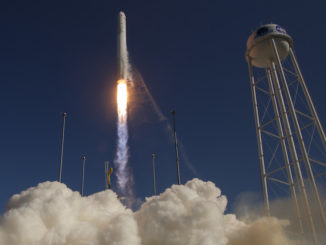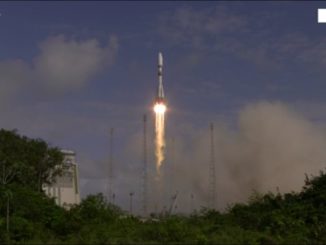Update: Starship completed a successful climb to approximately 10 kilometers altitude and descended horizontally toward the landing site. It appeared to lose control as it was in the process of flipping back to a vertical position and exploded as it bellyflopped onto the landing pad. We’ll have a full report later.
SpaceX defied public safety rules on its most recent Starship launch over South Texas in December, the Federal Aviation Administration said Tuesday as it approved a license for SpaceX’s next high-altitude Starship test flight scheduled for the same day.
In a statement, an FAA spokesperson said the agency determined late Monday that SpaceX “complies with all safety and related federal regulations and is authorized to conduct Starship SN9 flight operations in accordance with its launch license.”
SpaceX plans to fly the stainless steel test rocket to an altitude of about 10,000 meters, or 32,800 feet, with three methane-fueled Raptor engines. After taking off from its launch pedestal at SpaceX’s rocket factory and launch site in Boca Chica, Texas, the 164-foot-tall (50-meter) rocket will climb vertically and shut down its Raptor engines in succession, then tip over to a horizontal position and fall back to the ground, using actuating flaps and fins to control its descent.
Finally, seconds before reaching the ground, the Raptor engines will reignite and flip the rocket back vertical to attempt a propulsive landing on a pad next to the launch site on the Texas Gulf Coast.

The test window Tuesday opens at 9 a.m. CST and runs until 6:59 p.m. CST (10:00 a.m.-7:59 p.m. EST; 1400-2359 GMT). SpaceX will provide a live video stream of the SN9 test launch.
SpaceX is building and testing prototypes of its next-generation fully reusable Starship rocket, which the company says will be the most powerful launcher in history. The Starship will eventually fly with six Raptor engines, each producing about a half-million pounds of thrust, and will be stacked on stop of an even larger booster called the Super Heavy with around 28 Raptor engines.
The Starship will eventually be designed to re-enter the atmosphere from orbit and perform precision landings. The Super Heavy will land a few minutes after launch, much like the boosters on SpaceX’s operational Falcon rocket family.
The entire vehicle will stand nearly 400 feet, or about 120 meters, tall and carry more than 100 metric tons, or 220,000 pounds, of cargo to low Earth orbit, more than any rocket in the world. With life support systems and in-space refueling, Starship missions could eventually transport people to the moon, Mars, and other distant destinations.
Starship is central to the vision of SpaceX chief executive Elon Musk, who established the company with a mission of sending people to Mars. The Starship is also one of three vehicles vying for a NASA human-rated lunar lander contract to ferry astronauts to and from the moon’s surface.
But first, SpaceX is taking a fast-paced approach to testing the Starship system, first by flying prototypes of the upper stage and in-space transport segment of the huge rocket.
The flight profile for SN9 will be similar, but not identical, to SpaceX’s first high-altitude Starship test flight Dec. 9. On that flight, SpaceX said the Starship aimed to reach a maximum altitude of about 41,000 feet, or 12.5 kilometers, although the company never publicly confirmed how high the rocket actually flew.
The Dec. 9 test flight used SpaceX’s previous Starship test article, named Serial Number 8. The launch sequence and descent appeared to go according to plan, but the rocket crashed onto the landing pad at high speed after its Raptor engines failed to generate enough power to brake for touchdown.
SpaceX said low pressure in a fuel header tank, which feeds propellants into the Raptor engine bay for the landing burn, led to the hard landing.
The rocket was destroyed in a fireball, but SpaceX hailed the test flight as a success after gathering data and proving out much of the Starship’s atmospheric flight characteristics.
A replay of the Starship SN8 test flight is posted below.
Video credit: Stephen Clark / Spaceflight Now
What SpaceX and federal regulators did not say in December was that SpaceX apparently launched the rocket without FAA approval.
“Prior to the Starship SN8 test launch in December 2020, SpaceX sought a waiver to exceed the maximum public risk allowed by federal safety regulations,” an FAA spokesperson said Tuesday. “After the FAA denied the request, SpaceX proceeded with the flight.”
The FAA is responsible for licensing commercial space launches and re-entries conducted by all U.S. companies. The agency’s role is to ensure launch and re-entry providers comply with public safety rules, limiting the risk to the general population. The FAA also requires launch and re-entry providers to buy liability insurance to cover potential damage to property owned by third parties or the government, which helps ensure U.S. taxpayers are not on the hook to pay for cleanup or destroyed property.
It was not immediately clear if SpaceX was fined or paid any other penalty for launching the SN8 test flight without FAA approval.
The FAA said it grounded SpaceX’s Starship program after the company launched the SN8 test flight without the safety waiver. SpaceX rolled out the SN9 test vehicle, the next in the company’s mass-produced line of Starship prototypes, from the company’s assembly facility at Boca Chica to the seaside launch site for ground tests.
After a series of test-firings in January, SpaceX planned to launch the SN9 vehicle last week. The FAA issued airspace restrictions over the launch site in South Texas, but the agency did not grant final approval for the launch, prompting Elon Musk to criticize federal regulators on Twitter.
“Unlike its aircraft division, which is fine, the FAA space division has a fundamentally broken regulatory structure,” Musk tweeted Jan. 28. “Their rules are meant for a handful of expendable launches per year from a few government facilities. Under those rules, humanity will never get to Mars.”
The FAA said it required SpaceX to conduct an investigation of the SN8 incident.
“All testing that could affect public safety at the Boca Chica, Texas, launch site was suspended until the investigation was completed and the FAA approved the company’s corrective actions to protect public safety,” an FAA spokesperson said. “The corrective actions arising from the SN8 incident are incorporated into the SN9 launch license.”
Last week, SpaceX rolled out its next Starship prototype, SN10, to a second launch pad at Boca Chica to begin ground testing before it performs the company’s next test flight.
Jared Zambrano-Stout, a former FAA official and chief of staff of the National Space Council during the Trump administration, tweeted that he was in “complete shock” that SpaceX violated its launch license. “And there seems to be no repercussions,” he added.
“If a licensee violates the terms of their launch license, they did so knowing that an uninvolved member of the public could have been hurt or killed,” Zambrano-Stout wrote. “That is not exaggeration. They took a calculated risk with your life and property.
“Knowing that, the FAA has a responsibility, charged by Congress who granted them this responsibility in the first place, to enforce their licenses and the parameters of their licenses,” he added. “This is (because) every launch has the potential to harm the uninvolved public and taxpayers could be on the hook for damages through the indemnification regime. In other words, the FAA doesn’t really care about damages to the licensee, they are charged with protecting the public.
“If the FAA does not enforce their launch licenses, it will damage the long-term viability of the launch industry and damage their credibility with Congress,” Zambrano-Stout wrote. “It is possible that the industry could suffer significant regulatory burdens enforce by Congress to ensure safety.”
A SpaceX spokesperson did not respond to questions on the matter Tuesday morning.
Email the author.
Follow Stephen Clark on Twitter: @StephenClark1.



